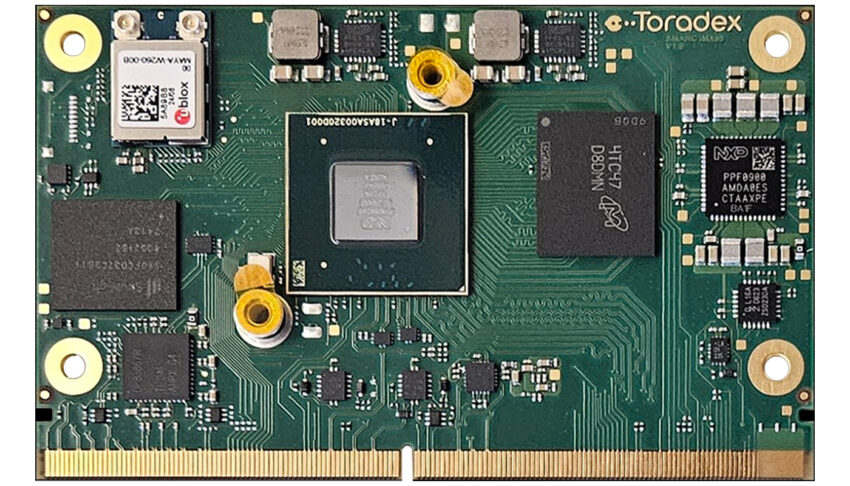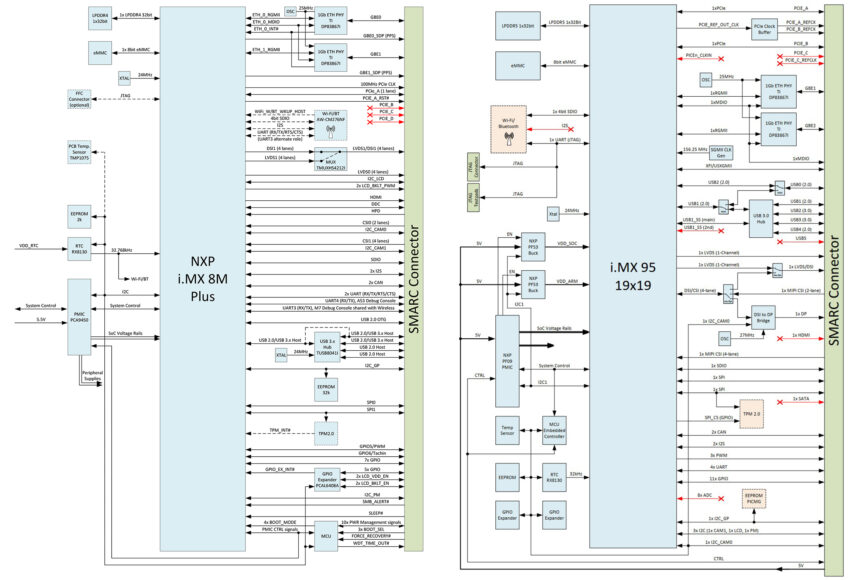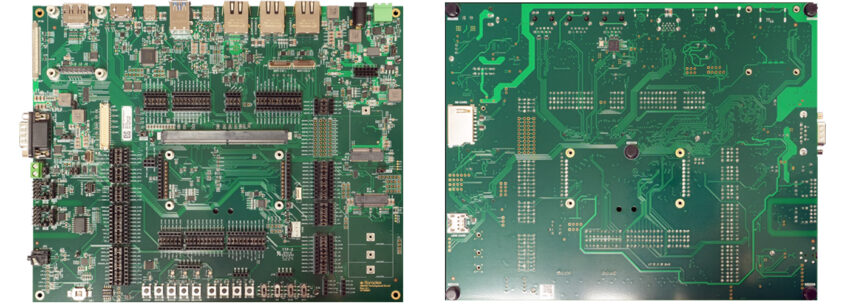
Toradex Expands SMARC Ecosystem with i.MX 8M Plus and i.MX 95 Modules Offering Long-Term Linux Support and Secure OTA Updates
The Toradex SMARC Family includes SMARC (Smart Mobility Architecture) modules that are built for reliable and easy-to-use embedded computing to help lower development costs and risks while working with the existing SMARC ecosystem. These SMARC modules are used in industrial automation, medical devices, transportation, robotics, and IoT applications.

Toradex offers industry-leading Linux support with long-term maintenance, an integrated secure remote update system (Torizon), and compliance with the EU Cyber Resilience Act (CRA). These modules are fully SMARC 2.2-compliant, ensuring compatibility with most SMARC 2.1/2.0 carrier boards. Toradex simplifies software migration, including transitioning from Windows to Linux, and offers hardware compatibility checks for seamless integration.

The iMX8M Plus and iMX95 modules feature ARM Cortex processors, Neural Processing Units (NPUs) for AI tasks, high-speed connectivity options like USB 3.2, PCIe, and Gigabit Ethernet, and multimedia capabilities with 4K HDMI, MIPI DSI, and CSI-2 interfaces. These modules are built to scale, have less power used, and have secure remote updates supported, long-term support is also received by them, making them a good fit for embedded systems that need to be reliable, safe, and flexible for industrial and commercial use.
Previously, Toradex introduced some similar SoMs (System on Module) including the Verdin AM62, the Aquila iMX95, and many more. We have also covered some other SoMs like the Forlinx FET-MX95xx-C, which is based on the same NXP i.MX 95 SoC as SMARC iMX95. Feel free to check them out if you are interested in those SoMs.
SMARC i.MX 8M Plus and i.MX 95 Modules Specifications:
- CPU:
- SMARC i.MX 8M Plus
- Quad-core Arm Cortex-A53 (1.6GHz) + Cortex-M7 (800MHz)
- Integrated NPU (2.3 TOPS), ISP, and 3D GPU
- SMARC i.MX 95
- Hexa-core Arm Cortex-A55 (1.8GHz) + Cortex-M7 (800MHz) + Cortex-M33 (333MHz)
- Integrated NPU (2.0 TOPS), ISP, and 3D GPU
- SMARC i.MX 8M Plus
- Memory:
- i.MX 8M Plus: 4GB LPDDR4 (32 bit)
- i.MX 95: 16GB LPDDR5 (32 bit)
- Storage:
- i.MX 8M Plus: 32GB eMMC
- i.MX 95: 64GB eMMC
- Connectivity:
- SMARC i.MX 8M Plus
- 1x Gigabit Ethernet with TSN (+2nd RGMII)
- Wi-Fi 5 (802.11ac) + Bluetooth 5.3
- SMARC i.MX 95
- 2x Gigabit Ethernet with TSN + 1x 10GbE with TSN
- Wi-Fi 6 (802.11ax) + Bluetooth 5.2
- SMARC i.MX 8M Plus
- Expansion:
- SMARC i.MX 8M Plus: PCIe Gen 3 (1x lane), 4x I2C, 2x SPI, 4x UART, 1x PWM,
- SMARC i.MX 95: PCIe Gen 3 (2x lanes), 5x I2C, 2x SPI, 4x UART, 3x PWM
- 1x SDIO/SD/MMC
- 2x CAN FD
- I/O:
- 1x MIPI-DSI
- 1x LVDS
- 1x HDMI (up to 4k)
- 1x DisplayPort (up to 4k)
- 2x MIPI-CSI for camera on i.MX 8M Plus
- 1x MIPI-CSI for camera on i.MX 95
- USB:
- SMARC i.MX 8M Plus
- 2x USB 3.1 OTG
- 5x USB 2.0
- SMARC i.MX 95
- 2x USB 3.2 Gen 1
- 3x USB 2.0
- SMARC i.MX 8M Plus
- Multimedia:
- Video Decode/Encode: H.264, H.265 (HEVC)
- Audio: 2x I2S digital audio support
- Misc:
- Triple Display Controller for SMARC i.MX 8M Plus
- Single (Dual Engine) Display Controller for SMARC i.MX 95
- Power: TBD
- Sizer: 82 x 50mm
- Operating Temperature: -40°C to 85°C
- Shock/Vibration: EN 60068-2-6/50g 20ms

Toradex SMARC modules support multiple operating systems, including Torizon, Yocto-based Embedded Linux, Toradex Easy Installer, FreeRTOS, QNX, Zephyr, and Android. Engineers design these modules for embedded computing in industries like industrial automation, medical devices, transportation, robotics, and IoT. They offer a secure boot, encryption, secure OTA updates, and compliance with the EU Cyber Resilience Act (CRA). With a focus on scalability, low power consumption, and long-term support, a reliable and flexible solution for industrial and commercial applications is provided by them.
The Toradex company also mentioned its SMARC Development Board with HDMI Adapter, a fully featured carrier board designed for developers, providing easy access to all interfaces of the SMARC module family, including both Toradex and third-party ARM-based SMARC modules.

It supports industry-standard interfaces such as USB 3.0, USB 2.0, Ethernet (3x Gigabit), PCIe, I2C, SPI, UART, PWM, GPIO, RS232, RS485, SDIO, CAN, and JTAG. Multimedia connectivity includes MIPI DSI, LVDS (via an optional adapter), HDMI (via an included adapter), DisplayPort, MIPI CSI for cameras, and multiple analogue and digital audio options. With its compact 250 x 200mm size and a 9-24V power input range, the board offers flexibility and scalability for various embedded applications.
SMARC Development Board with HDMI Adapter Specifications:
- Supported Modules
- Toradex SMARC Family & third-party ARM-based SMARC modules
- Storage:
- 1x Full-Size SD/SDIO/MMC Slot
- Ethernet:
- 3x Gigabit Ethernet
- PCIe:
- 1x M.2 Key E
- 1x M.2 Key B (+ Micro-SIM card connector)
- Serial Interfaces:
- 5x I²C
- 2x SPI
- 4x UART
- 3x PWM
- 14x GPIO
- 1x RS232
- 1x RS485
- I/O:
-
- Display Interfaces:
- 1x Quad Lane MIPI DSI
- 1x LVDS (via optional DSI to LVDS adapter)
- 1x HDMI (via included DSI to HDMI adapter)
- 1x DisplayPort
- Camera Interfaces:
- 1x Quad Lane MIPI CSI
- 1x Dual Lane MIPI CSI
- Other Interfaces:
- 2x CAN
- 1x JTAG
- Display Interfaces:
- Audio:
- 2x I²S (Digital Audio)
- 1x Stereo Line-In
- 1x Stereo Mic-In
- 1x Stereo Headphone-Out
- 1x Stereo Line-Out
- USB:
- 2x USB 3.0 Type-A (Host)
- 2x USB 2.0 Type-A (Host)
- 1x USB 2.0 Type-C (Debug)
- Power Input: 9-24V DC (+/-10%)
- Dimensions: 250 x 200 mm
- Operating Temperature: 0°C to 70°C
You can swap one module for another in theory, but there are always small differences. Things like memory, storage, and networking components may need software adjustments, and minor tweaks might be required on the carrier board. To help with this, Toradex provides a free compatibility check to estimate the effort needed to transition an SMARC design to its modules.
At the time of writing the company does not provide any pricing information and you need to contact the company through the product page for a quote. They also share why it introduced SMARC modules alongside its proprietary ones in the video below. You can find more details on the blog page of the Toradex website.
Leave a Comment